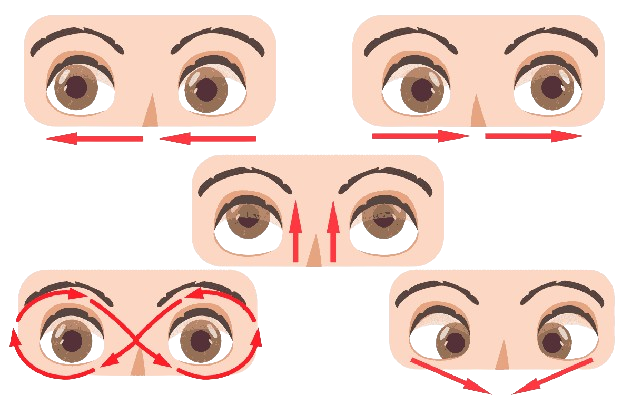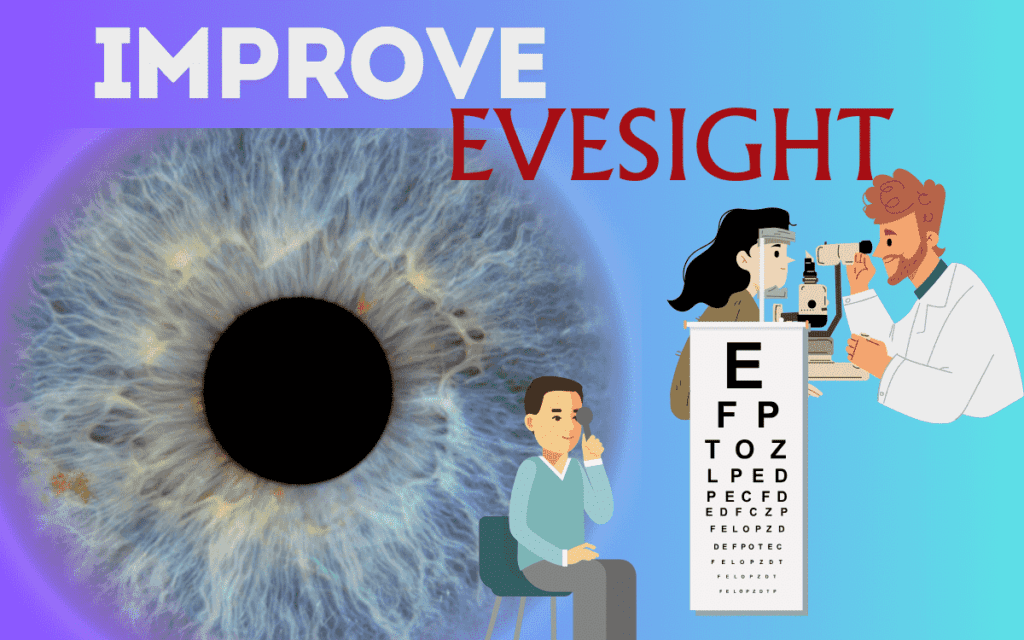How Can We Improve Eyesight
Proper Nutrition
Vitamins and Minerals: Ensure your diet is rich in vitamins A, C, and E, as well as minerals like zinc. These nutrients are found in foods like carrots, spinach, kale, and sweet potatoes.
Omega-3 Fatty Acids: Fish such as salmon and tuna are excellent sources of omega-3s, which are beneficial for eye health.
Lutein and Zeaxanthin: These antioxidants are found in green leafy vegetables, corn, and eggs, and they help protect the eyes from harmful light.
Regular Eye Exercises

20-20-20 Rule: Every 20 minutes, take a 20-second break and look at something 20 feet away. This reduces eye strain from screen time.
Focus Change: Hold your finger a few inches from your eye and focus on it, then shift your focus to something farther away. Repeat several times.
Eye Rolling: Roll your eyes in circular motions to help relax and strengthen the eye muscles.
Common Eye Conditions
Myopia (Nearsightedness):
- Definition: Difficulty seeing distant objects clearly due to the eyeball being too long or the cornea being too curved.
- Symptoms: Blurry vision for distant objects, squinting, eyestrain, headaches.
- Treatment:
- Glasses: Concave lenses correct the focus onto the retina.
- Contact lenses: Provide a wider field of vision compared to glasses.
- Refractive surgery (LASIK, PRK): Reshape the cornea to correct the focusing of light onto the retina.
Hyperopia (Farsightedness):
- Definition: Difficulty seeing close objects clearly due to the eyeball being too short or the cornea having too little curvature.
- Symptoms: Blurry vision for close objects, eyestrain (especially during close work), headaches.
- Treatment:
- Glasses: Convex lenses help focus light onto the retina.
- Contact lenses: Similar to glasses, they correct the focus onto the retina.
- Refractive surgery (LASIK, PRK): Reshape the cornea to correct the focusing of light onto the retina.
Astigmatism:
- Definition: Blurred or distorted vision caused by an irregularly shaped cornea or lens.
- Symptoms: Blurred or distorted vision at all distances, eyestrain, headaches.
- Treatment:
- Glasses: Lenses with a special cylindrical curvature to compensate for the irregular shape of the cornea or lens.
- Contact lenses (toric lenses): Specifically designed to correct astigmatism by aligning with the irregular curvature of the eye.
- Refractive surgery (LASIK, PRK): Reshape the cornea to correct the irregular curvature.
Presbyopia:
- Definition: Age-related difficulty focusing on close objects due to the lens becoming less flexible.
- Symptoms: Difficulty reading small print, holding reading materials at arm’s length, eyestrain, headaches.
- Treatment:
- Reading glasses: Convex lenses that magnify close-up objects.
- Bifocal or multifocal glasses: Combine prescriptions for both distance and near vision.
- Bifocal or multifocal contact lenses: Similar to glasses, but in contact lens form.
- Refractive surgery (multifocal IOLs): Intraocular lenses implanted during cataract surgery to improve both distance and near vision.
Other Eye Disorders:
Glaucoma:
- Definition: Damage to the optic nerve often due to increased intraocular pressure.
- Symptoms:
- Open-angle glaucoma (chronic): Often asymptomatic until significant vision loss occurs; gradual loss of peripheral vision.
- Angle-closure glaucoma (acute): Severe eye pain, nausea, vomiting, sudden onset of blurred vision, halos around lights.
- Treatment:
- Medications: Eye drops to reduce intraocular pressure.
- Laser surgery: Trabeculoplasty or iridotomy to improve fluid drainage.
- Conventional surgery: Trabeculectomy to create a new drainage channel.
Cataracts:
- Definition: Clouding of the eye’s natural lens.
- Symptoms:
- Early stages: Blurred or cloudy vision, faded colors, increased glare from lights.
- Advanced stages: Difficulty seeing at night, double vision in one eye, frequent changes in prescription.
- Treatment:
- Surgical removal: Phacoemulsification or extracapsular extraction to remove the cloudy lens and replace it with an artificial intraocular lens (IOL).
Macular Degeneration:
- Definition: Progressive damage to the macula, leading to loss of central vision.
- Symptoms:
- Dry AMD: Gradual central vision loss, blurred vision, difficulty recognizing faces or reading.
- Wet AMD: Sudden, distorted vision (straight lines appear wavy), rapid central vision loss.
- Treatment:
- Dry AMD: Nutritional supplements (AREDS formula), lifestyle changes.
- Wet AMD: Anti-VEGF injections to reduce abnormal blood vessel growth, photodynamic therapy, thermal laser therapy.
Natural Ways to Improve Vision and Eye Health
Improving vision and maintaining good eye health through natural methods is important for overall well-being. Here are some effective strategies:
Nutrition and Diet:
- Eat a balanced diet: Include foods rich in antioxidants (like fruits and vegetables), omega-3 fatty acids (found in fish), and vitamins C and E (found in citrus fruits, nuts, and seeds).
- Consider eye-friendly nutrients: Lutein and zeaxanthin (found in leafy greens like spinach and kale) and zinc (found in meats and nuts) are beneficial for eye health.
- Stay hydrated: Drink plenty of water to maintain moisture in your eyes.
Eye Exercises and Relaxation Techniques:
- Eye exercises: Practice focusing exercises, eye rolls, and blinking exercises to help strengthen eye muscles and reduce eye strain.
- Palming: Rub your palms together to generate heat and gently place them over your closed eyes for a few minutes to relax them.
- 20-20-20 rule: Every 20 minutes, look at something 20 feet away for at least 20 seconds to reduce eye strain from prolonged screen use.
Protecting Your Eyes from Strain and Injury:
- Proper lighting: Ensure adequate lighting when reading or using screens to reduce strain.
- Screen time management: Take breaks from digital screens regularly to prevent digital eye strain.
- Wear sunglasses: Protect your eyes from UV rays outdoors with sunglasses that block both UVA and UVB rays.
Healthy Lifestyle Choices:
Quit smoking: Smoking increases the risk of eye diseases like cataracts and age-related macular degeneration.
Regular exercise: Physical activity improves circulation, which can benefit eye health.
Manage chronic conditions: Control conditions like diabetes and hypertension that can affect vision.
Treating Vision and Eye Condition
Corrective Lenses: Glasses and Contact Lenses:
- Glasses: Prescription eyeglasses are the most common way to correct refractive errors such as nearsightedness (myopia), farsightedness (hyperopia), astigmatism, and presbyopia (age-related difficulty focusing on close objects).
- Contact lenses: These provide an alternative to glasses and can correct the same refractive errors. Contact lenses come in various types, including soft, rigid gas permeable, and specialized lenses for conditions like astigmatism and presbyopia.
Surgical Options: LASIK and Other Procedures:
- LASIK (Laser-Assisted in Situ Keratomileusis): A popular surgical procedure to correct refractive errors by reshaping the cornea using a laser. LASIK can reduce or eliminate the need for glasses or contacts for many patients.
- PRK (Photorefractive Keratectomy): Similar to LASIK but involves removing the surface layer of the cornea (epithelium) before reshaping the cornea with a laser.
- Lens replacement surgery: Used for treating presbyopia or cataracts by replacing the eye’s natural lens with an artificial intraocular lens (IOL).
Medications and Eye Drops:
- Prescription eye drops: Used to treat conditions such as glaucoma (to lower intraocular pressure), dry eyes (to increase tear production or reduce inflammation), and eye infections (to treat bacterial or viral infections).
- Topical medications: Ointments or creams prescribed for conditions affecting the eyelids or surrounding areas.
Vision Therapy and Rehabilitation:
Other Treatments and Therapies:
- Low vision aids: Devices like magnifiers, telescopes, and electronic magnification systems used to enhance vision for individuals with low vision.
- Orthokeratology (Ortho-K): Overnight contact lenses that temporarily reshape the cornea to correct refractive errors, particularly myopia.
Vision therapy: A customized program of eye exercises and activities prescribed by an optometrist or ophthalmologist to improve specific visual skills, such as eye coordination or focusing ability.
Orthoptics: Exercises and techniques used to improve eye alignment and coordination, often used in children with strabismus (crossed eyes).
Neuro-optometric rehabilitation: Specialized therapy for patients with traumatic brain injury, stroke, or other neurological conditions affecting vision.
Each treatment option has its indications and considerations based on the specific eye condition and individual needs. It’s important to consult with an eye care professional to determine the most suitable treatment approach for your situation. Regular eye exams are essential for monitoring eye health and ensuring that any vision changes are promptly addressed.
Conclusion
Maintaining optimal eye health is essential for overall well-being. By understanding risk factors and common conditions such as refractive errors, cataracts, and glaucoma, you can take preventive measures like adopting a balanced diet rich in eye-friendly nutrients, wearing UV-protective sunglasses, and avoiding smoking. Regular comprehensive eye exams are crucial for early detection and timely treatment of any eye issues.
Encouraging a proactive approach to eye care ensures that you prioritize your vision health throughout your life. Remember to seek professional advice promptly for any changes in vision or discomfort. By making these adjustments and integrating healthy habits into your daily routine, you can effectively safeguard your vision and enjoy optimal eye health for years to come.
